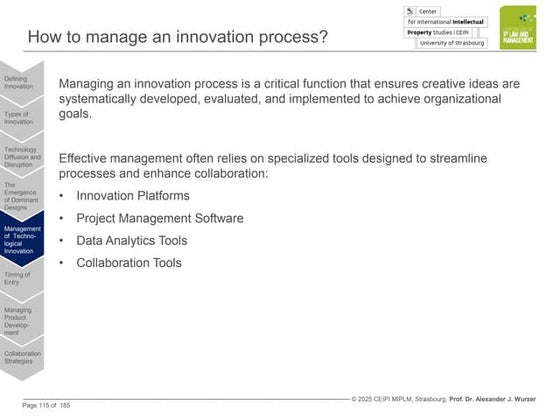Programming in C [Module One]
Download as PPSX, PDF1 like570 views
A step to fulfill the desire of the students who wish to learn Programming from scratch... Chapter One - Concept of C
1 of 17
Downloaded 20 times
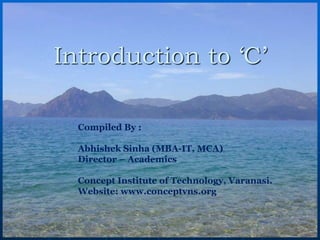






![’é¦ Operator Types:
Can be categorized on the basis of two criteria's:
a) No of Operands
b) Operation Performed
ŌĆó Unary Operator (1 operand)
ŌĆó Binary Operator (2 operand)
ŌĆó Ternary Operator (3 operand)
ŌĆó Arithmetic Operator (+, -, *, /, %)
ŌĆó Assignment Operator (=)
ŌĆó Relational Operator (<, <=, ==, >, >=, !=)
ŌĆó Logical Operator (&&, ||, !)
ŌĆó Conditional Operator ( ? :)
ŌĆó Increment/Decrement Operator (++, --)
ŌĆó Bitwise Operator (&, |, ~, ^, <<, >>)
ŌĆó Some Special Operators ( [], (), *, ., ->,
malloc, calloc, realloc, sizeof, free)](https://image.slidesharecdn.com/programmingincchapterone-150312070001-conversion-gate01/85/Programming-in-C-Module-One-8-320.jpg)









Recommended
Concepts of C [Module 2]![Concepts of C [Module 2]](https://cdn.slidesharecdn.com/ss_thumbnails/conceptsofcm2-p1-150416080853-conversion-gate02-thumbnail.jpg?width=560&fit=bounds)
![Concepts of C [Module 2]](https://cdn.slidesharecdn.com/ss_thumbnails/conceptsofcm2-p1-150416080853-conversion-gate02-thumbnail.jpg?width=560&fit=bounds)
![Concepts of C [Module 2]](https://cdn.slidesharecdn.com/ss_thumbnails/conceptsofcm2-p1-150416080853-conversion-gate02-thumbnail.jpg?width=560&fit=bounds)
![Concepts of C [Module 2]](https://cdn.slidesharecdn.com/ss_thumbnails/conceptsofcm2-p1-150416080853-conversion-gate02-thumbnail.jpg?width=560&fit=bounds)
Concepts of C [Module 2]Abhishek Sinha
╠²
It is an attempt to make the students of IT understand the basics of programming in C in a simple and easy way. Send your feedback for rectification/further development. Input And Output



Input And OutputGhaffar Khan
╠²
The document discusses input and output functions in C programming. It describes getchar() and putchar() for character input/output, printf() and scanf() for formatted input/output, and gets() and puts() for string input/output. It provides examples of using these functions to read input from the keyboard and display output to the screen.What is c



What is cNitesh Saitwal
╠²
C programming is a widely used programming language. The document provides an overview of key concepts in C programming including variables, data types, operators, decision and loop control statements, functions, pointers, arrays, strings, structures, and input/output functions. It also provides examples to illustrate concepts like arrays, strings, functions, pointers, and structures. The main function is the entry point for all C programs where code execution begins.Basic Input and Output



Basic Input and OutputNurul Zakiah Zamri Tan
╠²
The document discusses various input and output functions in C programming. It describes scanf() and printf() for input and output without spaces, gets() and puts() for multi-word input and output, getchar() and putchar() for single character input and output, and getch() and putch() for single character input and output without pressing enter. It also covers format specifiers used with these functions and escape sequences.Mesics lecture 5 input ŌĆō output in ŌĆścŌĆÖ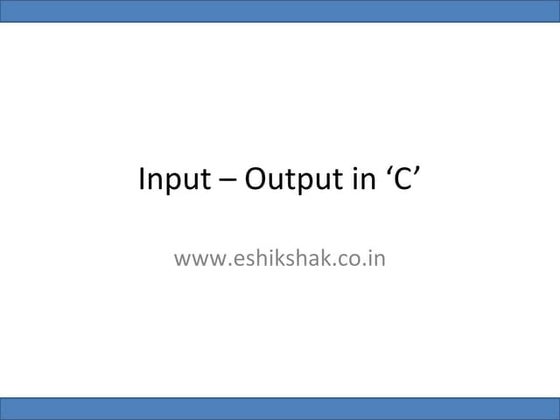



Mesics lecture 5 input ŌĆō output in ŌĆścŌĆÖeShikshak
╠²
1. There are two main ways to handle input-output in C - formatted functions like printf() and scanf() which require format specifiers, and unformatted functions like getchar() and putchar() which work only with characters.
2. Formatted functions allow formatting of different data types like integers, floats, and strings. Unformatted functions only work with characters.
3. Common formatted functions include printf() for output and scanf() for input. printf() outputs data according to format specifiers, while scanf() reads input and stores it in variables based on specifiers.Input Output Management In C Programming



Input Output Management In C ProgrammingKamal Acharya
╠²
This document discusses input/output functions in C programming, including printf() and scanf(). It explains how to use format specifiers like %d, %f, %s with printf() to output variables of different types. It also covers escape sequences like \n, \t that control formatting. Scanf() uses similar format specifiers to read input from the keyboard into variables. The document provides examples of using printf() and scanf() with different format specifiers and modifiers.C programming Workshop



C programming Workshopneosphere
╠²
Programming is an essential skill if you seek a career in software development, or in other fields of Coding. This fundamental of programming course is the first in the specialization for Introduction to Programming in C, but its lessons extend to any language you might want to study. This is because programming is primarily about solving a set of problems and writing the algorithm.7. input and output functions



7. input and output functionsWay2itech
╠²
This document discusses input and output functions in C programming and integers. It provides examples of using format specifiers like %d to print integers. It shows how to declare, assign, and perform math operations on integers. It also demonstrates getting input from the user using scanf and printing output with printf. The document ends by prompting the reader to write a program to calculate simple interest by getting principal, rate, and time inputs from the user.C fundamentals



C fundamentalsshaheed benazeer bhutto university (shaheed benazeerabad)
╠²
This chapter discusses fundamental concepts of C programming language and basic input/output functions. It covers C development environment, C program structure including main functions and statements, basic data types, input/output functions like printf and scanf, and common programming errors.Data Input and Output



Data Input and OutputSabik T S
╠²
This document discusses input and output functions in C. It explains that C uses streams for all input and output, with standard streams for input (stdin), output (stdout), and errors (stderr). The main I/O functions covered are getchar() and putchar() for single characters, scanf() and printf() for formatted input and output, and gets() and puts() for strings. It provides examples of how to use each function and notes that strings are null-terminated in C.CPU INPUT OUTPUT 



CPU INPUT OUTPUT Aditya Vaishampayan
╠²
The document discusses input and output functions in C programming. It describes formatted functions like printf() and scanf() that allow input and output with formatting. It also describes unformatted functions like getchar(), putchar(), gets(), and puts() that handle character and string input/output without formatting. The formatted functions require format specifiers while the unformatted functions work only with character data types.Unit ii ppt



Unit ii pptANJALAI AMMAL MAHALINGAM ENGINEERING COLLEGE
╠²
This document provides an overview of C programming basics including character sets, tokens, keywords, variables, data types, and control statements in C language. Some key points include:
- The C character set includes lowercase/uppercase letters, digits, special characters, whitespace, and escape sequences.
- Tokens in C include operators, special symbols, string constants, identifiers, and keywords. There are 32 reserved keywords that should be in lowercase.
- Variables are named locations in memory that hold values. They are declared with a data type and initialized by assigning a value.
- C has primary data types like int, float, char, and double. Derived types include arrays, pointers, unions, structures,Managing input and output operations in c



Managing input and output operations in cniyamathShariff
╠²
Managing input and output operations in c it also include types and format
unfiormatted I/o functions and maney moreIntroduction to Basic C programming 02



Introduction to Basic C programming 02Wingston
╠²
This presentation offers complete basic users a simple guide to the C programming Language in a practical mannerIntroduction to C programming



Introduction to C programmingSabik T S
╠²
This document discusses various elements of the C programming language including character sets, delimiters, keywords, identifiers, constants, variables, data types, initializing variables, comments, and more. It provides examples of valid and invalid declarations of variables in C and describes the basic data types including char, int, float, double, and void along with their typical ranges.Input output statement in C



Input output statement in CMuthuganesh S
╠²
The document discusses input/output functions in C programming. It describes the scanf() function for input, which reads data from variables using format specifiers in a control string. It also describes printf() for output, which prints values to the screen using format specifiers. Additional functions getchar() and putchar() are discussed for reading and writing single characters respectively.C programming(Part 1)



C programming(Part 1)Dr. SURBHI SAROHA
╠²
This document provides an overview of key concepts in C programming including data types, variables, constants, arithmetic expressions, assignment statements, and logical expressions. It discusses how integers, characters, and floating-point numbers are represented in C. It also explains the different types of constants and variables as well as the various arithmetic, assignment, and logical operators supported in C. Examples are provided to demonstrate the use of these operators.7 functions



7 functionsMomenMostafa
╠²
The document discusses functions in C programming. It provides examples of defining functions with parameters and return types, calling functions by passing arguments, using header files to declare functions, and recursion. It shows functions being defined and called to perform tasks like calculating factorials, displaying prices based on hotel rates and nights, and converting numbers to binary. Functions allow breaking programs into smaller, reusable components.1 introducing c language



1 introducing c languageMomenMostafa
╠²
This document provides an overview of the C programming language course contents which includes data types, operators, control statements, functions, arrays, pointers, input/output and string functions. It also discusses the seven steps of programming, C strengths such as efficiency and portability, weaknesses like not being object-oriented, and provides simple C program examples and explanations.Important C program of Balagurusamy Book



Important C program of Balagurusamy BookAbir Hossain
╠²
This document contains summaries of multiple programming labs involving different programming concepts like functions, arrays, strings, conditionals, loops, etc. The labs cover basics like printing an address, calculating expressions, finding roots of equations, computing trigonometric functions; conditionals like determining if a number is even/odd, larger/smaller; functions including calculating factorial, power series, fibonacci series; arrays for storing student marks, vote counting; strings for manipulation and analysis.Programming in C (part 2)



Programming in C (part 2)Dr. SURBHI SAROHA
╠²
This document provides an overview of various programming concepts in C including sequencing, alterations, iterations, arrays, string processing, subprograms, and recursion. It discusses each topic at a high level, providing examples. For arrays, it describes how to declare and initialize arrays in C and provides a sample code to initialize and print elements of an integer array. For recursion, it explains the concept and provides a recursive function to calculate the factorial of a number as an example.C introduction by thooyavan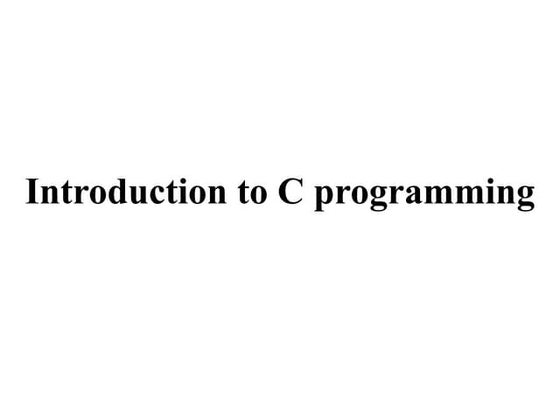



C introduction by thooyavanThooyavan Venkatachalam
╠²
This document provides an introduction to the C programming language. It discusses the history and development of C, how C programs are structured, and the basic building blocks or tokens of C code like keywords, identifiers, constants, and operators. It also covers various data types in C, input and output functions, decision making and looping statements, functions, arrays, pointers, structures, unions, and file handling. The document is intended to give beginners an overview of the essential components of the C language.C Programming Language Part 6



C Programming Language Part 6Rumman Ansari
╠²
Loops allow code to be executed repeatedly. The main loop types are while, for, and do-while loops. While and do-while loops test the condition at the beginning or end of the loop respectively. For loops allow code to be executed a specific number of times. Loops can be nested by placing one loop inside another. Break and continue statements control the flow of loops. Break exits the current loop while continue skips to the next iteration. Though goto can provide unconditional jumps, its use is discouraged due to reducing code readability.C programming(part 3)



C programming(part 3)Dr. SURBHI SAROHA
╠²
The document discusses various topics in C programming including structures, unions, pointers, I/O statements, debugging, and testing techniques. It provides examples to explain structures as a way to represent records by combining different data types. Unions allow storing different data types in the same memory location. Pointers are variables that store memory addresses. I/O statements like printf and scanf are used for input and output. Debugging methods include detecting incorrect program behavior and fixing bugs. Testing and verification ensure programs are built correctly according to requirements.4 operators, expressions & statements



4 operators, expressions & statementsMomenMostafa
╠²
This document discusses various C programming language concepts including operators, expressions, statements, data types, and type conversions. It provides examples of using unary and binary operators, increment/decrement operators, and the modulus operator. It also discusses operator precedence, expressions, statements, and how C handles type conversions between integers, floats, and characters both automatically and through explicit casting. Loops and conditional statements are demonstrated in examples converting seconds to minutes and counting down bottles of water.Decision making and branching



Decision making and branchingSaranya saran
╠²
The document discusses different types of selection and looping structures in C programming such as if-else statements, switch statements, while loops, for loops, and nested loops. It provides syntax examples and sample code to demonstrate if-else ladders, nested if statements, while, do-while and for loops. Examples include calculating grades based on marks, finding roots of quadratic equations, Fibonacci series, swapping values and reversing numbers.Expressions using operator in c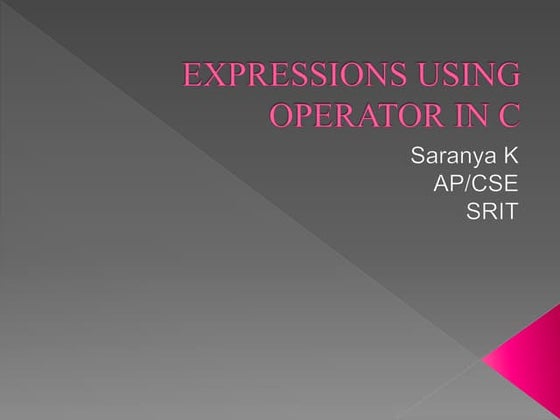



Expressions using operator in cSaranya saran
╠²
C provides various built-in operators to manipulate data and variables. These operators can be classified as arithmetic, relational, logical, bitwise, assignment, conditional, and special operators. Arithmetic operators perform basic math operations like addition and subtraction. Relational operators compare values. Logical operators combine conditional statements. Bitwise operators perform manipulations at the bit level. Assignment operators assign values. Conditional operators provide an if-else statement in a single line. Precedence and associativity determine the order of evaluation for expressions containing multiple operators.UNIT-II CP DOC.docx



UNIT-II CP DOC.docxJavvajiVenkat
╠²
The document discusses various input and output functions in C programming. It describes formatted and unformatted input/output functions. Formatted functions like scanf() and printf() require format specifiers to identify the data type being read or written. Unformatted functions like getchar() and putchar() only work with character data. The document also covers control statements like if, if-else, switch case that allow conditional execution of code in C. Examples are provided to demonstrate the use of various input, output and control functions.C material



C materialtarique472
╠²
The document provides an overview of the C programming language, including its history, basic structure, data types, operators, input/output, decision making, looping, functions, arrays, pointers, strings, structures, file handling, and linked data structures. Some key topics covered include the C compilation process, basic C program structure, common data types like int and char, arithmetic, relational, and logical operators, if/else and switch statements, while, do-while and for loops, defining functions, and passing arguments to functions.More Related Content
What's hot (20)
C fundamentals



C fundamentalsshaheed benazeer bhutto university (shaheed benazeerabad)
╠²
This chapter discusses fundamental concepts of C programming language and basic input/output functions. It covers C development environment, C program structure including main functions and statements, basic data types, input/output functions like printf and scanf, and common programming errors.Data Input and Output



Data Input and OutputSabik T S
╠²
This document discusses input and output functions in C. It explains that C uses streams for all input and output, with standard streams for input (stdin), output (stdout), and errors (stderr). The main I/O functions covered are getchar() and putchar() for single characters, scanf() and printf() for formatted input and output, and gets() and puts() for strings. It provides examples of how to use each function and notes that strings are null-terminated in C.CPU INPUT OUTPUT 



CPU INPUT OUTPUT Aditya Vaishampayan
╠²
The document discusses input and output functions in C programming. It describes formatted functions like printf() and scanf() that allow input and output with formatting. It also describes unformatted functions like getchar(), putchar(), gets(), and puts() that handle character and string input/output without formatting. The formatted functions require format specifiers while the unformatted functions work only with character data types.Unit ii ppt



Unit ii pptANJALAI AMMAL MAHALINGAM ENGINEERING COLLEGE
╠²
This document provides an overview of C programming basics including character sets, tokens, keywords, variables, data types, and control statements in C language. Some key points include:
- The C character set includes lowercase/uppercase letters, digits, special characters, whitespace, and escape sequences.
- Tokens in C include operators, special symbols, string constants, identifiers, and keywords. There are 32 reserved keywords that should be in lowercase.
- Variables are named locations in memory that hold values. They are declared with a data type and initialized by assigning a value.
- C has primary data types like int, float, char, and double. Derived types include arrays, pointers, unions, structures,Managing input and output operations in c



Managing input and output operations in cniyamathShariff
╠²
Managing input and output operations in c it also include types and format
unfiormatted I/o functions and maney moreIntroduction to Basic C programming 02



Introduction to Basic C programming 02Wingston
╠²
This presentation offers complete basic users a simple guide to the C programming Language in a practical mannerIntroduction to C programming



Introduction to C programmingSabik T S
╠²
This document discusses various elements of the C programming language including character sets, delimiters, keywords, identifiers, constants, variables, data types, initializing variables, comments, and more. It provides examples of valid and invalid declarations of variables in C and describes the basic data types including char, int, float, double, and void along with their typical ranges.Input output statement in C



Input output statement in CMuthuganesh S
╠²
The document discusses input/output functions in C programming. It describes the scanf() function for input, which reads data from variables using format specifiers in a control string. It also describes printf() for output, which prints values to the screen using format specifiers. Additional functions getchar() and putchar() are discussed for reading and writing single characters respectively.C programming(Part 1)



C programming(Part 1)Dr. SURBHI SAROHA
╠²
This document provides an overview of key concepts in C programming including data types, variables, constants, arithmetic expressions, assignment statements, and logical expressions. It discusses how integers, characters, and floating-point numbers are represented in C. It also explains the different types of constants and variables as well as the various arithmetic, assignment, and logical operators supported in C. Examples are provided to demonstrate the use of these operators.7 functions



7 functionsMomenMostafa
╠²
The document discusses functions in C programming. It provides examples of defining functions with parameters and return types, calling functions by passing arguments, using header files to declare functions, and recursion. It shows functions being defined and called to perform tasks like calculating factorials, displaying prices based on hotel rates and nights, and converting numbers to binary. Functions allow breaking programs into smaller, reusable components.1 introducing c language



1 introducing c languageMomenMostafa
╠²
This document provides an overview of the C programming language course contents which includes data types, operators, control statements, functions, arrays, pointers, input/output and string functions. It also discusses the seven steps of programming, C strengths such as efficiency and portability, weaknesses like not being object-oriented, and provides simple C program examples and explanations.Important C program of Balagurusamy Book



Important C program of Balagurusamy BookAbir Hossain
╠²
This document contains summaries of multiple programming labs involving different programming concepts like functions, arrays, strings, conditionals, loops, etc. The labs cover basics like printing an address, calculating expressions, finding roots of equations, computing trigonometric functions; conditionals like determining if a number is even/odd, larger/smaller; functions including calculating factorial, power series, fibonacci series; arrays for storing student marks, vote counting; strings for manipulation and analysis.Programming in C (part 2)



Programming in C (part 2)Dr. SURBHI SAROHA
╠²
This document provides an overview of various programming concepts in C including sequencing, alterations, iterations, arrays, string processing, subprograms, and recursion. It discusses each topic at a high level, providing examples. For arrays, it describes how to declare and initialize arrays in C and provides a sample code to initialize and print elements of an integer array. For recursion, it explains the concept and provides a recursive function to calculate the factorial of a number as an example.C introduction by thooyavan



C introduction by thooyavanThooyavan Venkatachalam
╠²
This document provides an introduction to the C programming language. It discusses the history and development of C, how C programs are structured, and the basic building blocks or tokens of C code like keywords, identifiers, constants, and operators. It also covers various data types in C, input and output functions, decision making and looping statements, functions, arrays, pointers, structures, unions, and file handling. The document is intended to give beginners an overview of the essential components of the C language.C Programming Language Part 6



C Programming Language Part 6Rumman Ansari
╠²
Loops allow code to be executed repeatedly. The main loop types are while, for, and do-while loops. While and do-while loops test the condition at the beginning or end of the loop respectively. For loops allow code to be executed a specific number of times. Loops can be nested by placing one loop inside another. Break and continue statements control the flow of loops. Break exits the current loop while continue skips to the next iteration. Though goto can provide unconditional jumps, its use is discouraged due to reducing code readability.C programming(part 3)



C programming(part 3)Dr. SURBHI SAROHA
╠²
The document discusses various topics in C programming including structures, unions, pointers, I/O statements, debugging, and testing techniques. It provides examples to explain structures as a way to represent records by combining different data types. Unions allow storing different data types in the same memory location. Pointers are variables that store memory addresses. I/O statements like printf and scanf are used for input and output. Debugging methods include detecting incorrect program behavior and fixing bugs. Testing and verification ensure programs are built correctly according to requirements.4 operators, expressions & statements



4 operators, expressions & statementsMomenMostafa
╠²
This document discusses various C programming language concepts including operators, expressions, statements, data types, and type conversions. It provides examples of using unary and binary operators, increment/decrement operators, and the modulus operator. It also discusses operator precedence, expressions, statements, and how C handles type conversions between integers, floats, and characters both automatically and through explicit casting. Loops and conditional statements are demonstrated in examples converting seconds to minutes and counting down bottles of water.Decision making and branching



Decision making and branchingSaranya saran
╠²
The document discusses different types of selection and looping structures in C programming such as if-else statements, switch statements, while loops, for loops, and nested loops. It provides syntax examples and sample code to demonstrate if-else ladders, nested if statements, while, do-while and for loops. Examples include calculating grades based on marks, finding roots of quadratic equations, Fibonacci series, swapping values and reversing numbers.Expressions using operator in c



Expressions using operator in cSaranya saran
╠²
C provides various built-in operators to manipulate data and variables. These operators can be classified as arithmetic, relational, logical, bitwise, assignment, conditional, and special operators. Arithmetic operators perform basic math operations like addition and subtraction. Relational operators compare values. Logical operators combine conditional statements. Bitwise operators perform manipulations at the bit level. Assignment operators assign values. Conditional operators provide an if-else statement in a single line. Precedence and associativity determine the order of evaluation for expressions containing multiple operators.UNIT-II CP DOC.docx



UNIT-II CP DOC.docxJavvajiVenkat
╠²
The document discusses various input and output functions in C programming. It describes formatted and unformatted input/output functions. Formatted functions like scanf() and printf() require format specifiers to identify the data type being read or written. Unformatted functions like getchar() and putchar() only work with character data. The document also covers control statements like if, if-else, switch case that allow conditional execution of code in C. Examples are provided to demonstrate the use of various input, output and control functions.Similar to Programming in C [Module One] (20)
C material



C materialtarique472
╠²
The document provides an overview of the C programming language, including its history, basic structure, data types, operators, input/output, decision making, looping, functions, arrays, pointers, strings, structures, file handling, and linked data structures. Some key topics covered include the C compilation process, basic C program structure, common data types like int and char, arithmetic, relational, and logical operators, if/else and switch statements, while, do-while and for loops, defining functions, and passing arguments to functions.Chap 2 c++



Chap 2 c++Widad Jamaluddin
╠²
The document discusses editing, compiling, and executing a simple C++ program. It begins with an overview of basic C++ programming elements and concepts like tokens, data types, arithmetic operators, and precedence. It then provides examples of simple C++ programs that perform arithmetic calculations and output results. The document emphasizes that understanding programming fundamentals like variables, data types, expressions, and control flow is necessary before writing even basic C++ programs.C++ Introduction to basic C++ IN THIS YOU WOULD KHOW ABOUT BASIC C++



C++ Introduction to basic C++ IN THIS YOU WOULD KHOW ABOUT BASIC C++sanatahiratoz0to9
╠²
it is slide on basic introduction of c++Data Type in C Programming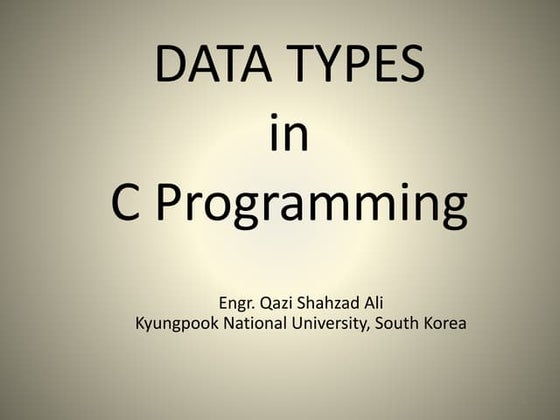



Data Type in C ProgrammingQazi Shahzad Ali
╠²
This document provides an overview of data types in C programming, including:
1) It describes four main types of data types - fundamental, modifiers, derived, and user defined. Fundamental types include integer, character, float, void. Modifiers change properties of other types. Derived types include arrays and pointers.
2) It explains the integer, float, character, and void fundamental data types in more detail. Integer can be short, int, long. Float and double store numbers in mantissa and exponent. Character represents keyboard characters.
3) Common C data type sizes and value ranges are provided for integer, float, and character types along with their modifiers like short, long, signed, unsigned.C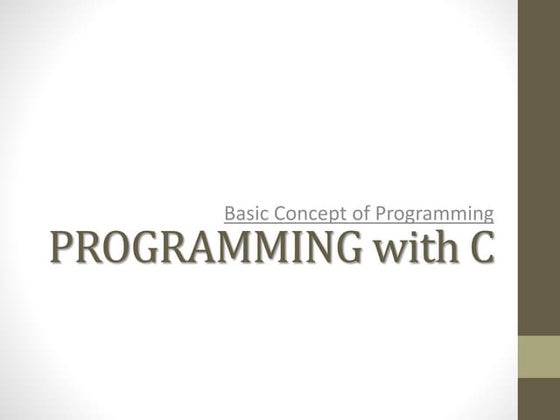



CJerin John
╠²
The document provides an overview of the C programming language. It discusses basic C programming concepts like data types, variables, functions, pointers, structures, file handling and more. It also includes examples of basic C programs and code snippets to illustrate various programming concepts.Presentation c++



Presentation c++JosephAlex21
╠²
The document provides an introduction to programming in C++. It discusses the software development cycle including compiling, linking, and debugging programs. It also covers key programming concepts like variables, data types, functions, classes and objects. The evolution of C++ from C is described. Input/output statements like cout and cin are demonstrated along with basic program structure.Lecture 2



Lecture 2Mahfuzur Rahman
╠²
The document provides an overview of a computer programming lecture on C programming. It covers the following topics:
1. The history of C and basics of C programming including program structure, data types, and variables.
2. Recommended books for learning C programming.
3. What C is, why it is useful, and its uses in operating systems, databases, device drivers and other applications.
4. The software development method and types of programming languages such as machine language, assembly language, and high-level languages.C tutorials



C tutorialsAmit Kapoor
╠²
C is a general-purpose programming language widely used to develop operating systems and compilers. It was developed in the early 1970s at Bell Labs by Dennis Ritchie. Some key reasons for C's popularity include its efficiency, ability to access low-level hardware, and ability to be compiled on a variety of computers. C source code files use a .c extension and must be compiled into an executable binary file before running. Common uses of C include operating systems, language compilers, databases, and network drivers.C programming language



C programming languageAbin Rimal
╠²
This document provides an introduction to the C programming language. It discusses that C was developed in 1972 by Dennis Ritchie at Bell Labs to create the UNIX operating system. C is a structured, procedural programming language that is widely used to develop operating systems, databases, networks, and more. The document then covers some key concepts in C including functions, header files, variables, data types, operators, and escape sequences. It provides examples of basic C programs and exercises for practicing programming concepts.#Code2 create c++ for beginners 



#Code2 create c++ for beginners GDGKuwaitGoogleDevel
╠²
#Code2Create series: C++ is a powerful general-purpose programming language. It can be used to develop operating systems, browsers, games, and so on. C++ supports different ways of programming like procedural, object-oriented, functional, and so on.Start your programming journey and join us to learn C++ basics!
by Google Developers Group and Women Tech-markers Kuwait chapter:
Instagram and Twitter: @GDGWTMKUWAITLearn c language Important topics ( Easy & Logical, & smart way of learning)



Learn c language Important topics ( Easy & Logical, & smart way of learning)Rohit Singh
╠²
Learn C language with an easy way including all important topics in C.
Learn c language Important topics ( Easy & Logical, & smart way of learning)
preprocessor Directive, Search Strategy, Header file, return 0 in C, return, main function, flow of execution, explicit return, function, return type and non return type function. Run- time Environment, type specifier, void keyword, 32 keyword in C, openning curly brace and closing curly brace, system library, single argument, String literal is an unnamed array with element of type char.C notes



C notesRaunak Sodhi
╠²
C is a general purpose programming language developed in the 1970s. It has features like control structures, looping statements, and arrays that make it well-suited for business and scientific applications. A C program executes in four steps - creating the program, compiling it, linking it to libraries, and executing the final executable file. C has keywords, variables, data types, operators, and conditional statements that allow for structured programming and control flow.introductory concepts



introductory conceptsWalepak Ubi
╠²
The document introduces fundamental programming concepts including variables, constants, data types, and operators. It discusses defining and declaring variables and constants, their naming rules and scope. The key data types in C like char, int, float and double are explained along with their ranges. The types of operators - arithmetic, relational, logical and their use in expressions are defined. Finally, it shows how to convert formulas into C expressions and the relationship between operands, operators and expressions.Fundamentals of Data Structures Unit 1.pptx



Fundamentals of Data Structures Unit 1.pptxVigneshkumar Ponnusamy
╠²
This document outlines the objectives and topics covered in the course EC8393 - Fundamentals of Data Structures in C. The course aims to teach students about linear and non-linear data structures and their applications using the C programming language. Key topics include implementing various data structure operations in C, choosing appropriate data structures, and modifying existing or designing new data structures for applications. Assessment includes continuous internal assessments, a university exam, and a minimum 80% attendance requirement.The smartpath information systems c pro



The smartpath information systems c proThe Smartpath Information Systems,Bhilai,Durg,Chhattisgarh.
╠²
The document provides an overview of the C programming language, including its history, characteristics, environment, structure, data types, variables, decision making, looping, libraries, and uses. It describes how C was developed at Bell Labs in the early 1970s and later standardized. The summary highlights C's small fixed set of keywords, static typing, use of headers and functions, and popularity for systems programming and performance-critical applications due to its efficiency and ability to access hardware.The smartpath information systems c pro



The smartpath information systems c proThe Smartpath Information Systems,Bhilai,Durg,Chhattisgarh.
╠²
Recently uploaded (20)
¤ōŻ Marketing is Everything in the Beauty Business! ¤Æģ¤ÅŠŌ£© Talent gets you in the ...



¤ōŻ Marketing is Everything in the Beauty Business! ¤Æģ¤ÅŠŌ£© Talent gets you in the ...coreylewis960
╠²
¤ōŻ Marketing is Everything in the Beauty Business! ¤Æģ¤ÅŠŌ£©
Talent gets you in the gameŌĆöbut visibility keeps your chair full.
TodayŌĆÖs top stylists arenŌĆÖt just skilledŌĆötheyŌĆÖre seen.
ThatŌĆÖs where MyFi Beauty comes in.
¤ī¤ We Help You Get Noticed with Tools That Work:
¤ō▒ Social Media Scheduling & Strategy
We make it easy for you to stay consistent and on-brand across Instagram, Facebook, TikTok, and more.
YouŌĆÖll get content prompts, captions, and posting tools that do the work while you do the hair.
¤¢ź’ĖÅ Your Own Personal Beauty App
Stand out from the crowd with a custom app made just for you. Clients can:
Book appointments
Browse your services
View your gallery
Join your email/text list
Leave reviews & refer friends
¤¢╝’ĖÅ Offline Marketing Made Easy
We provide digital flyers, QR codes, and branded business cards that connect straight to your appŌĆöturning strangers into loyal clients with just one tap.
¤Ä» The Result?
You build a strong personal brand that reaches more people, books more clients, and grows with you. Whether youŌĆÖre just starting out or trying to level upŌĆöMyFi Beauty is your silent partner in success.
Enhancing SoTL through Generative AI -- Opportunities and Ethical Considerati...



Enhancing SoTL through Generative AI -- Opportunities and Ethical Considerati...Sue Beckingham
╠²
This presentation explores the role of generative AI (GenAI) in enhancing the Scholarship of Teaching and Learning (SoTL), using FeltenŌĆÖs five principles of good practice as a guiding framework. As educators within higher education institutions increasingly integrate GenAI into teaching and research, it is vital to consider how these tools can support scholarly inquiry into student learning, while remaining contextually grounded, methodologically rigorous, collaborative, and appropriately public.
Through practical examples and case-based scenarios, the session demonstrates how generative GenAI can assist in analysing critical reflection of current practice, enhancing teaching approaches and learning materials, supporting SoTL research design, fostering student partnerships, and amplifying the reach of scholarly outputs. Attendees will gain insights into ethical considerations, opportunities, and limitations of GenAI in SoTL, as well as ideas for integrating GenAI tools into their own scholarly teaching practices. The session invites critical reflection and dialogue about the responsible use of GenAI to enhance teaching, learning, and scholarly impact.
Knownsense 2025 Finals-U-25 General Quiz.pdf



Knownsense 2025 Finals-U-25 General Quiz.pdfPragya - UEM Kolkata Quiz Club
╠²
Knownsense is the General Quiz conducted by Pragya the Official Quiz Club of the University of Engineering and Management Kolkata in collaboration with Ecstasia the official cultural fest of the University of Engineering and Management Kolkata Pass SAP C_C4H47_2503 in 2025 | Latest Exam Questions & Study Material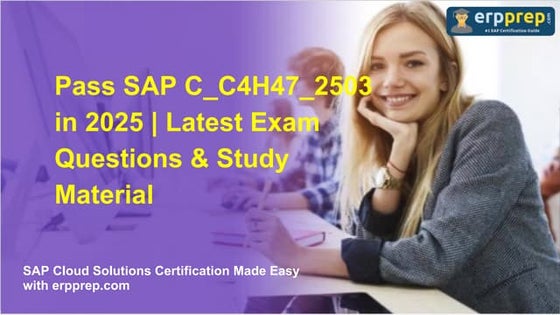



Pass SAP C_C4H47_2503 in 2025 | Latest Exam Questions & Study MaterialJenny408767
╠²
Pass SAP C_C4H47_2503 with expert-designed practice tests & real questions. Start preparing today with ERPPrep.com and boost your SAP Sales Cloud career! 3. AI Trust Layer, Governance ŌĆō Explainability, Security & Compliance.pdf



3. AI Trust Layer, Governance ŌĆō Explainability, Security & Compliance.pdfMukesh Kala
╠²
AI Trust Layer, Governance ŌĆō Explainability, Security & ComplianceHow to Setup Company Data in Odoo 17 Accounting App



How to Setup Company Data in Odoo 17 Accounting AppCeline George
╠²
The Accounting module in Odoo 17 is a comprehensive tool designed to manage all financial aspects of a business. It provides a range of features that help with everything from day-to-day bookkeeping to advanced financial analysis. CLEFT LIP AND PALATE: NURSING MANAGEMENT.pptx



CLEFT LIP AND PALATE: NURSING MANAGEMENT.pptxPRADEEP ABOTHU
╠²
Cleft lip, also known as cheiloschisis, is a congenital deformity characterized by a split or opening in the upper lip due to the failure of fusion of the maxillary processes. Cleft lip can be unilateral or bilateral and may occur along with cleft palate. Cleft palate, also known as palatoschisis, is a congenital condition characterized by an opening in the roof of the mouth caused by the failure of fusion of the palatine processes. This condition can involve the hard palate, soft palate, or both.How to Install Odoo 18 with Pycharm - Odoo 18 ║▌║▌▀Żs



How to Install Odoo 18 with Pycharm - Odoo 18 ║▌║▌▀ŻsCeline George
╠²
In this slide weŌĆÖll discuss the installation of odoo 18 with pycharm. Odoo 18 is a powerful business management software known for its enhanced features and ability to streamline operations. Built with Python 3.10+ for the backend and PostgreSQL as its database, it provides a reliable and efficient system. Different perspectives on dugout canoe heritage of Soomaa.pdf



Different perspectives on dugout canoe heritage of Soomaa.pdfAivar Ruukel
╠²
Sharing the story of haabjas to 1st-year students of the University of Tartu MA programme "Folkloristics and Applied Heritage Studies" and 1st-year students of the Erasmus Mundus Joint Master programme "Education in Museums & Heritage". ANORECTAL MALFORMATIONS: NURSING MANAGEMENT PPT.pptx



ANORECTAL MALFORMATIONS: NURSING MANAGEMENT PPT.pptxPRADEEP ABOTHU
╠²
Anorectal malformations refer to a range of congenital anomalies that involve the anus, rectum, and sometimes the urinary and genital organs. They result from abnormal development during the embryonic stage, leading to incomplete or absent formation of the rectum, anus, or both.
How to Manage Check Out Process in Odoo 17 Website



How to Manage Check Out Process in Odoo 17 WebsiteCeline George
╠²
Checkout process is a final step before processing the purchase. At this step we review the product, add shipping details and confirm the purchase.Anti-Fungal Agents.pptx Medicinal Chemistry III B. Pharm Sem VI



Anti-Fungal Agents.pptx Medicinal Chemistry III B. Pharm Sem VISamruddhi Khonde
╠²
UNIT ŌĆō IV
Antifungal agents:
Antifungal antibiotics: Amphotericin-B, Nystatin, Natamycin, Griseofulvin.
Synthetic Antifungal agents: Clotrimazole, Econazole, Butoconazole,
Oxiconazole Tioconozole, Miconazole*, Ketoconazole, Terconazole,
Itraconazole, Fluconazole, Naftifine hydrochloride, Tolnaftate*O SWEET SPONTANEOUS BY EDWARD ESTLIN CUMMINGSAN.pptx



O SWEET SPONTANEOUS BY EDWARD ESTLIN CUMMINGSAN.pptxAituzazKoree
╠²
O SWEET SPONTANEOUS
explain
Themes10.socialorganisationandsocialsystem .pptx



10.socialorganisationandsocialsystem .pptxVivek Bhattji
╠²
SOCIAL ORGANIATION & SOCIAL DISORGANIZATION
APPLIED SOCIOLOGY 20250402 ACCA TeamScienceAIEra 20250402 v10.pptx



20250402 ACCA TeamScienceAIEra 20250402 v10.pptxhome
╠²
Team Science in the AI Era: Talk for the Association of Cancer Center Administrators (ACCA) Team Science Network (April 2, 2025, 3pm ET)
Host: Jill Slack-Davis (https://www.linkedin.com/in/jill-slack-davis-56024514/)
20250402 Team Science in the AI Era
These slides: TBD
Jim Twin V1 (English video - Heygen) - https://youtu.be/T4S0uZp1SHw
Jim Twin V1 (French video - Heygen) - https://youtu.be/02hCGRJnCoc
Jim Twin (Chat) Tmpt.me Platform ŌĆō https://tmpt.app/@jimtwin
Jim Twin (English video ŌĆō OpenSource) ŌĆō https://youtu.be/mwnZjTNegXE
Jim Blog Post - https://service-science.info/archives/6612
Jim EIT Article (Real Jim) - https://www.eitdigital.eu/newsroom/grow-digital-insights/personal-ai-digital-twins-the-future-of-human-interaction/
Jim EIT Talk (Real Jim) - https://youtu.be/_1X6bRfOqc4
Reid Hoffman (English video) - https://youtu.be/rgD2gmwCS10A-Z GENERAL QUIZ | THE QUIZ CLUB OF PSGCAS | 14TH MARCH 2025.pptx



A-Z GENERAL QUIZ | THE QUIZ CLUB OF PSGCAS | 14TH MARCH 2025.pptxQuiz Club of PSG College of Arts & Science
╠²
Behold a thrilling general quiz set brought to you by THE QUIZ CLUB OF PSG COLLEGE OF ARTS & SCIENCE, COIMBATORE, made of 26 questions for the each letter of the alphabet and covering everything above the earth and under the sky.
Explore the trivia , knowledge , curiosity
So, get seated for an enthralling quiz ride.
Quizmaster : THANVANTH N A (Batch of 2023-26), THE QUIZ CLUB OF PSG COLLEGE OF ARTS & SCIENCE, CoimbatoreAnti-Viral Agents.pptx Medicinal Chemistry III, B Pharm SEM VI



Anti-Viral Agents.pptx Medicinal Chemistry III, B Pharm SEM VISamruddhi Khonde
╠²
Antiviral agents are crucial in combating viral infections, causing a variety of diseases from mild to life-threatening. Developed through medicinal chemistry, these drugs target viral structures and processes while minimizing harm to host cells. Viruses are classified into DNA and RNA viruses, with each replicating through distinct mechanisms. Treatments for herpesviruses involve nucleoside analogs like acyclovir and valacyclovir, which inhibit the viral DNA polymerase. Influenza is managed with neuraminidase inhibitors like oseltamivir and zanamivir, which prevent the release of new viral particles. HIV is treated with a combination of antiretroviral drugs targeting various stages of the viral life cycle. Hepatitis B and C are treated with different strategies, with nucleoside analogs like lamivudine inhibiting viral replication and direct-acting antivirals targeting the viral RNA polymerase and other key proteins.
Antiviral agents are designed based on their mechanisms of action, with several categories including nucleoside and nucleotide analogs, protease inhibitors, neuraminidase inhibitors, reverse transcriptase inhibitors, and integrase inhibitors. The design of these agents often relies on understanding the structure-activity relationship (SAR), which involves modifying the chemical structure of compounds to enhance efficacy, selectivity, and bioavailability while reducing side effects. Despite their success, challenges such as drug resistance, viral mutation, and the need for long-term therapy remain.¤ōŻ Marketing is Everything in the Beauty Business! ¤Æģ¤ÅŠŌ£© Talent gets you in the ...



¤ōŻ Marketing is Everything in the Beauty Business! ¤Æģ¤ÅŠŌ£© Talent gets you in the ...coreylewis960
╠²
A-Z GENERAL QUIZ | THE QUIZ CLUB OF PSGCAS | 14TH MARCH 2025.pptx



A-Z GENERAL QUIZ | THE QUIZ CLUB OF PSGCAS | 14TH MARCH 2025.pptxQuiz Club of PSG College of Arts & Science
╠²
Programming in C [Module One]
- 1. Introduction to ŌĆśCŌĆÖ Compiled By : Abhishek Sinha (MBA-IT, MCA) Director ŌĆō Academics Concept Institute of Technology, Varanasi. Website: www.conceptvns.org
- 2. What is C ? - Programming Language ’ü« Language is a medium of communication. It is a system for encoding & decoding information. ’ü« Program is a set of instructions to be followed in a particular fashion to accomplish a particular task. ’ü« Programming is a process to develop a program
- 3. A Programming Language is an artificial language designed to express computations that can be performed by a machine, particularly a computer.
- 4. Brief Introduction of C ’ü« C is a programming language that follows the philosophy of POP (Procedural Oriented Programming) categorized under High Level Language (some times under Middle Level Language). ’ü« Developed by ŌĆ£Dennis RitchieŌĆØ in the year 1972 at AT & T Bell Laboratory, USA. ’ü« It uses Compiler as a language translator to convert C instruction to executable code.
- 5. Historical Development of C Year Language Developer Remarks 1960 ALGOL International Committee Too general, too abstract 1963 CPL Cambridge University Hard to learn, difficult to implement 1967 BCPL Martin Richards, Cambridge University Could deal with only specific problems 1970 B Ken Thompson, AT & T Could deal with only specific problems 1972 C Dennis Ritchie, AT & T Lost generality of BCPL & B restored ALGOL : Algorithmic Language CPL : Combined Programming Language BCPL : Basic Combined Programming Language
- 6. Basic Building Blocks ’ü« Variables: ŌĆśthe values which can be changed or changes itselfŌĆÖ, e.g. salary, age, time etc.. ’ü« Constants: ŌĆśthe values which neither can be changed nor changes itselfŌĆÖ, e.g. PIE, G(gravitational constant), g (gravitational acceleration) etc.. ’ü« Identifiers: ŌĆśit is the name given to a value by which we can identify whether it is a variable or a constantŌĆÖ
- 7. ’ü« Keywords: ŌĆśreserved words whose meaning is predefined to the complier & whenever compiler comes across those words, it does the appropriate taskŌĆÖ. 32 reserved words are there in C such as goto, break, continue, return, void etc.. ’ü« Operators: are the special symbols which when applied on operands, gives us some manipulated result, and result depends on type of operator applied.
- 8. ’é¦ Operator Types: Can be categorized on the basis of two criteria's: a) No of Operands b) Operation Performed ŌĆó Unary Operator (1 operand) ŌĆó Binary Operator (2 operand) ŌĆó Ternary Operator (3 operand) ŌĆó Arithmetic Operator (+, -, *, /, %) ŌĆó Assignment Operator (=) ŌĆó Relational Operator (<, <=, ==, >, >=, !=) ŌĆó Logical Operator (&&, ||, !) ŌĆó Conditional Operator ( ? :) ŌĆó Increment/Decrement Operator (++, --) ŌĆó Bitwise Operator (&, |, ~, ^, <<, >>) ŌĆó Some Special Operators ( [], (), *, ., ->, malloc, calloc, realloc, sizeof, free)
- 9. ’é¦ Data Type: Tells us about three facts that a programmer must know and is very important: ŌĆó Type of value we can work on C Language ŌĆó Memory space required to store that value (size depends on Operating System) ŌĆó Range of value it can store in that space Making the use of these facts programmer reserves the space for its data accordingly.
- 10. We can categorize Data Type in two flavors ŌĆóPrimary Data Type ŌĆóNumeric ŌĆóInteger ŌĆóShort ŌĆóSigned ŌĆóUnsigned ŌĆóLong ŌĆóReal ŌĆóFloat ŌĆóDouble ŌĆóLong Double ŌĆóNon Numeric ŌĆóCharacter ŌĆóSigned ŌĆóUnsigned ŌĆóString (implemented as array) ŌĆóSecondary Data Type ŌĆóDerived Data Type ŌĆóArray ŌĆóPointer ŌĆóFunction ŌĆóUser Defined Data Type ŌĆóStructure ŌĆóUnion ŌĆóEnum *At this stage our concern topic is Primary Data Type
- 11. Integer ŌĆō denoted as int ŌĆō by default it is signed int Type Size (in bytes) Range Format String short int 2 -32768 to +32767 %d signed int 2 -32768 to +32767 %d unsigned int 2 0 to 65535 %u long int 4 -2147483648 to +2147483647 %ld Real Type Size (in bytes) Range Format String float 4 3.4e-38 to 3.4e+38 %f double 4 1.7e-308 to 1.7e+308 %lf long double 8 3.4e-4932 to 3.4e+4932 %le Character ŌĆō denoted as char ŌĆō by default it is signed char Type Size (in bytes) Range Format String signed char 1 -128 to +127 %c unsigned char 1 0 to 255 %c
- 12. ’ü« Variable Declaration: A process to reserve space in memory for data values, where those space are identified by the name of the variable for further reference. Syntax: <data_type> <variable_name>; Example: int age; // by default takes signed int This very statement makes the compiler to reserve two byte of space in memory and identifies it with the name age. age name of location location in memory 102 base address of location MEMORY REPRESENTATION
- 13. ’ü« Variable Initialization: A process to assign initial value to a variable at the time of declaration. By default it takes garbage value (depends on storage class specifier) Syntax: <data_type> <variable_name> = <initial_value>; Example: int age = 10; This very statement makes the compiler to reserve two byte of space in memory and identifies it with the name age and assigns 10 as its initial value. age name of location location in memory 102 base address of location MEMORY REPRESENTATION 10
- 14. C Program Structure Statements Example 1. Documentation / Commnet Section /*Sample Program*/ 2. Header File Inclusion #include<stdio.h> 3. Macro Definition #define MAX 10 4. Global Variable Declaration int x; 5. Sub-function(s) <RT> <Function Name>(<AL>) { //body of function } 6. Main function main() { //body of main }
- 15. Compilation Process Source code (.c) Object code (.obj) Expanded code (.i ) Assembly code (.asm) Executable code (.exe) Pre-Processing Compiling Assembling Linking & Loading Making
- 16. First of all we make our source file with an extension .c, now the code is expanded based on Preprocessor Directives used and is stored in a file having .i extension. From this code compiler checks for syntax errors. If it is error free, compiler converts it to the assembly language of the machine being used. This is stored in file having .asm extension. Now the assembler creates .obj file. Then linking and loading software makes the link with other files if included in source code and those files are loaded in memory. Now the making process creates .exe file which is executed/run and gives our output. Meanwhile at back scene another file is created having .bak extension which keeps the back-up of source code.
- 17. END OF CHAPTER ONE Send your feedback/queries at abhisheksinha786@gmail.com





